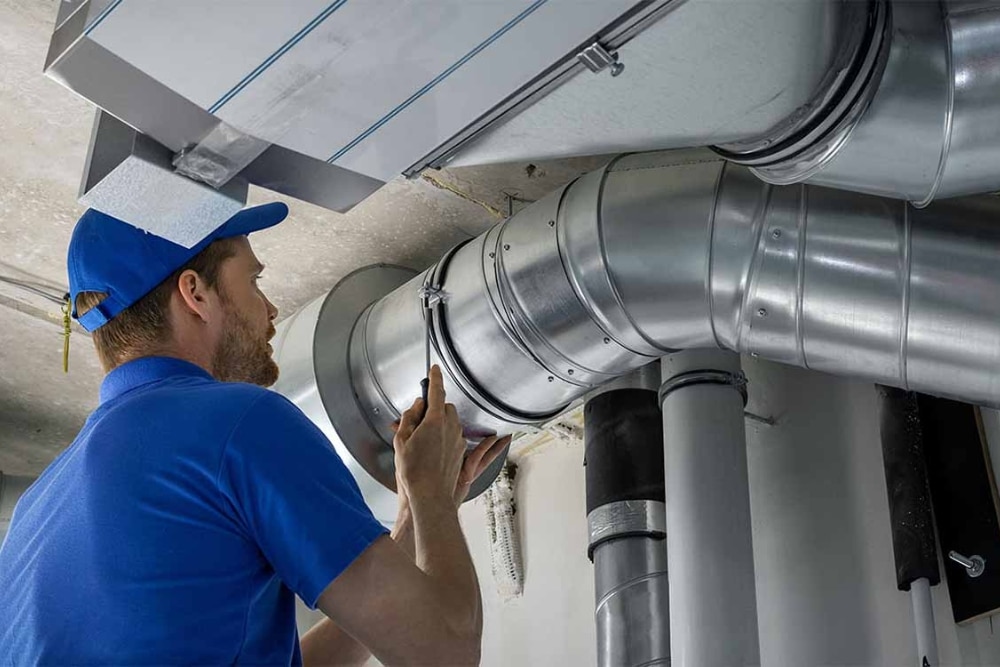The air ducts of your home are a vital part of the efficiency of your heating and cooling systems, and therefore, a direct reflection of your comfort, energy bills, and quality of indoor air. These ducts degrade with time and become ineffective and obsolete. When that happens, you may incur higher energy costs and a poor air quality, forcing you to replace them. This leads to the inevitable question in the minds of homeowners: How much does ac duct replacement cost?
In this article, we detail the major aspects influencing the air duct replacement, break down typical costs, and give you insight into how to get a good installation.
Important Factors Influencing Cost
The average cost for air duct replacement in Orange County varies greatly across the United States. Replacing the ductwork for an entire home is usually between $1,367 and $5,967 but can reach from a minimum of $250 to a maximum of $12,000. Due to a number of influential factors such as duct size, the material used, and the complexity of a project, costs can significantly differ. Most HVAC technicians quote based on the price of a duct, charging on average $295 to replace a single duct.
Let’s review the key determinants driving ac duct replacement cost a little more closely.
Duct Material Type Cost by Duct Material Type
The most significant factor involved in the cost of an air duct replacement is the duct material type. The common materials used in HVAC air duct replacement are listed next, along with their estimated average costs per linear foot
Fiberglass Ducts ($4–$7 per foot): Fiberglass is in demand because it can absorb noise and has structural strength to handle high air pressure. Fiberglass ducting is suitable for those who prefer quiet homes; however, the life expectancy of this is not as long as the metal ducting, and the fact that it degrades can make it shorter lived.
Aluminum Ducts ($2–$6 per foot): Aluminum ductwork is a favorite for its flexibility and lightweight property, making it easier to install in tight spaces. Aluminum ducting can last well over 25 years, reducing energy loss and thus ultimately improving the overall efficiency of your HVAC system, keeping the air duct installation cost, at bay.
Galvanized Steel Ducts ($4–$12 per foot): It is a sturdy product that will live longer than 50 years. Air flows easier because the surface is flat; this might translate into better efficiency. Sure, they cost more at installation, but steel ductwork will easily pay for itself in years to come, since they last so much longer.
Insulated Flex Ducts ($2–$7 per foot): Insulated flex ducts are lightweight, flexible, and durable. Insulated flex ducts will maintain the indoor air quality by keeping out pollutants. Their life span is around 20–25 years, shorter than that of metal ducts, but it has the convenience of installation and flexibility to reach the tightest spaces.
Non-Insulated Flex Ducts ($1–$3 per foot): These cost less, but are of use where the space may be confined, and pliability is essential. On the downside, they attract insects and therefore may deteriorate quicker over time.
Polyester Ducts ($1–$4 per foot): Polyester is a higher quality product, resistant to wear, and durable. However, they are very susceptible to insects. A middle of the road, between the two, durability and price, option.
Additional Cost Factors
Insulation
Enhancing energy efficiency by reducing heat in or out of the ducts can be achieved by adding or replacing insulation. The addition of this element adds some significant costs for labor and materials, up to $2-$6 per linear foot depending on the amount added
House Size
For larger homes, replacing the ductwork means that a larger area needs to be covered. This amounts to more materials and labor that increase the air duct installation cost. Replacing the ductwork in a smaller house might mean the lower end of the price range, while it may push the cost higher for a bigger house.
Adding Vents
More vents improve the airflow but bring about the complexity of duct layout, hence, usually leads to increasing the ac duct replacement cost by about $200 to $250 per vent because of the addition of materials, labor, and design costs.
Modification and Accessibility
One key area of air duct replacement cost is through inaccessible regions such as in crawl space or basement due to using specialized labor and equipment.
Some of them may involve more custom layout or settings that would attract more supplies and experienced labour.
Signs your air ducts needs to be replaced
A few telltale signs suggest that it might be time to replace your air ducts. Early recognition of these signs will help you address the issue before it impacts energy efficiency or air quality. Here are some common symptoms of deteriorating ductwork:
- Visible dust and dirt in air vents. This may suggest leaks or poor sealing in the ductwork.
- Rising energy bills without explanation are also an indication that ducts may be the issue.
- Excessive dust, especially around the vents, might indicate damage or leakage to the ductwork.
You’ll know that immediate replacement for health purposes is necessary if mold smells from the ductwork.
Uneven temperatures where one room is always warmer or cooler than others, it might be due to improper airflow from failing ducts.
Whistling or odd noises might be a sign of leaks or blockages, and in such cases, replacement may be required.
DIY vs. Professional Air Duct Replacement
While some homeowners may be motivated to save on the installation cost of air ducts by doing it themselves, replacing air ducts is often best left to professionals. Proper duct replacement requires knowledge, tools, and experience that an HVAC professional will have. The wrong installation can lead to efficiency problems, poor indoor air quality, and safety risks.
The right decision of hiring a certified HVAC professional will ensure that the ducts in your home get replaced correctly and safely, bringing long-term benefits to comfort and energy efficiency.
Frequently Asked Questions
- When do I know my air ducts need to be replaced?
Indications might be rising energy bills, uneven room temperatures, molds or dust on vents, or unusual noises, in which case you might replace your ducts.
- Can I do it myself?
While possible DIY replacement, it is suggested to hire a professional in order to install it safely and efficiently and meeting the requirements of local building codes.
- How long will it take?
Usually, replacement takes about 4-8 hours, depending on the size and complexity of the system.
- Will replacing my air ducts improve my HVAC system’s efficiency?
Yes, new ductwork can increase HVAC efficiency and result in reduced energy costs as well as better air distribution.
- Do I get financing for the replacement of the air duct?
Yes, most contractors will allow one to have a financing option or payment plan whereby the person can be catered for in the setting up of the air duct.
Conclusion
While air duct replacement is an expansive investment in your home, it may significantly affect comfort levels, indoor air quality, and energy efficiency of your home. Knowing which variables may influence the air duct replacement cost may prove a crucial factor in taking much more informed decisions, meaning you make the most suitable use of the money used. If you experience signs suggestive of air duct replacement, reach out to an expert, have them inspect it for you, and get a quotation.
That would really save time, money, and even some health risks down the road because high-quality ductwork also optimizes comfort and efficiency in a house.

